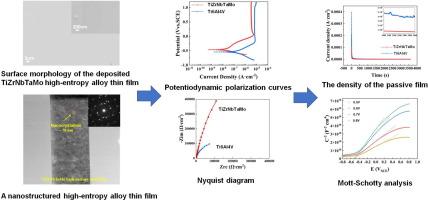当前位置:
X-MOL 学术
›
Appl. Surf. Sci.
›
论文详情
Our official English website, www.x-mol.net, welcomes your
feedback! (Note: you will need to create a separate account there.)
A nanostructured TiZrNbTaMo high-entropy alloy thin film with exceptional corrosion properties for biomedical application
Applied Surface Science ( IF 6.3 ) Pub Date : 2024-11-20 , DOI: 10.1016/j.apsusc.2024.161859 Man–Zhen Lin, Xuan Xiao, Chen-Hao Xu, Wenjun Lu, Yong Zhang, Wei–Bing Liao
Applied Surface Science ( IF 6.3 ) Pub Date : 2024-11-20 , DOI: 10.1016/j.apsusc.2024.161859 Man–Zhen Lin, Xuan Xiao, Chen-Hao Xu, Wenjun Lu, Yong Zhang, Wei–Bing Liao

|
High-entropy alloys (HEAs) have attracted extensive attention for biomedical application due to their excellent corrosion resistance. In this study, a simple body-center cubic TiZrNbTaMo nanostructured high-entropy alloy thin film (HEATF) was synthesized via magnetron sputtering. Its microstructure, phase structure and corrosion properties were identified by SEM, TEM, electrochemical tests and XPS, respectively. The corrosion properties of this nanostructured TiZrNbTaMo HEATF were studied in phosphate buffer solution at 37 ℃. It was found that the nanocrystals were randomly distributed in the HEATF, and the average grain size was statistically counted to be ∼ 70 nm. This nanostructured TiZrNbTaMo HEATF showed a higher open circuit potential value (−328 mVSCE), lower corrosion current density (0.017 μA/cm2) as compared with the traditional Ti6Al4V alloy. The cyclic polarization experiments implied that this nanostructured HEATF was not prone to local corrosion. The constant potential polarization demonstrated that the density of the passive film (k = -0.96) formed on the surface the nanostructured TiZrNbTaMo HEATF was better than that of the Ti6Al4V alloy (k = -0.87). Furthermore, the Mott-Schotty analysis showed that the passive film formed on the nanostructured TiZrNbTaMo HEATF exhibited n-type semiconductor. The donor density was smaller than that of the Ti6Al4V alloy at the same film forming potential, verifying that the HEATF’s passive film had higher stability and lower conductivity. The exceptional corrosion properties of this TiZrNbTaMo HEATF were ascribed to the synergistic effects of multiple elements, nanocrystal structure, and a stable surface passive film formation.
中文翻译:

一种纳米结构的 TiZrNbTaMo 高熵合金薄膜,具有优异的生物医学应用腐蚀性能
高熵合金 (HEA) 因其优异的耐腐蚀性而在生物医学应用中引起了广泛关注。在本研究中,通过磁控溅射合成了一种简单的体心立方 TiZrNbTaMo 纳米结构高熵合金薄膜 (HEATF)。其微观结构、物相结构和腐蚀性能分别通过 SEM、TEM、电化学测试和 XPS 鉴定。在 37 °C 的磷酸盐缓冲溶液中研究了这种纳米结构的 TiZrNbTaMo HEATF 的腐蚀性能。结果发现纳米晶体在 HEATF 中随机分布,平均晶粒尺寸为 ∼ 70 nm。与传统的 Ti6Al4V 合金相比,这种纳米结构的 TiZrNbTaMo HEATF 显示出更高的开路电位值 (-328 mVSCE),更低的腐蚀电流密度 (0.017 μA/cm2)。循环极化实验表明,这种纳米结构的 HEATF 不易受到局部腐蚀。恒定电位极化表明,纳米结构的 TiZrNbTaMo HEATF 表面形成的钝化膜密度 (k = -0.96) 优于 Ti6Al4V 合金 (k = -0.87)。此外,Mott-Schotty 分析表明,在纳米结构的 TiZrNbTaMo HEATF 上形成的钝化薄膜表现出 n 型半导体。在相同的成膜电位下,供体密度小于 Ti6Al4V 合金,验证了 HEATF 的钝化膜具有更高的稳定性和更低的电导率。这种 TiZrNbTaMo HEATF 的卓越腐蚀性能归因于多种元素、纳米晶体结构和稳定的表面钝化膜形成的协同作用。
更新日期:2024-11-20
中文翻译:

一种纳米结构的 TiZrNbTaMo 高熵合金薄膜,具有优异的生物医学应用腐蚀性能
高熵合金 (HEA) 因其优异的耐腐蚀性而在生物医学应用中引起了广泛关注。在本研究中,通过磁控溅射合成了一种简单的体心立方 TiZrNbTaMo 纳米结构高熵合金薄膜 (HEATF)。其微观结构、物相结构和腐蚀性能分别通过 SEM、TEM、电化学测试和 XPS 鉴定。在 37 °C 的磷酸盐缓冲溶液中研究了这种纳米结构的 TiZrNbTaMo HEATF 的腐蚀性能。结果发现纳米晶体在 HEATF 中随机分布,平均晶粒尺寸为 ∼ 70 nm。与传统的 Ti6Al4V 合金相比,这种纳米结构的 TiZrNbTaMo HEATF 显示出更高的开路电位值 (-328 mVSCE),更低的腐蚀电流密度 (0.017 μA/cm2)。循环极化实验表明,这种纳米结构的 HEATF 不易受到局部腐蚀。恒定电位极化表明,纳米结构的 TiZrNbTaMo HEATF 表面形成的钝化膜密度 (k = -0.96) 优于 Ti6Al4V 合金 (k = -0.87)。此外,Mott-Schotty 分析表明,在纳米结构的 TiZrNbTaMo HEATF 上形成的钝化薄膜表现出 n 型半导体。在相同的成膜电位下,供体密度小于 Ti6Al4V 合金,验证了 HEATF 的钝化膜具有更高的稳定性和更低的电导率。这种 TiZrNbTaMo HEATF 的卓越腐蚀性能归因于多种元素、纳米晶体结构和稳定的表面钝化膜形成的协同作用。


















































 京公网安备 11010802027423号
京公网安备 11010802027423号